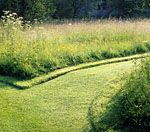Dream Acres week twelve: landscaping details
Our final instalment of Dream Acres moves the focus onto the details of laying out our dream estate


A freshly mown path meandering through a wildflower meadow, a kissing gate set into a dry-stone wall, a comfortable bench beneath a honeysuckle arbour it can be relatively simple things that make or break a garden.
If you’ve achieved perfection in every other area, then the right paths, fences, walls, gates, furniture and tools will serve to complete the picture. If, on the other hand, your garden is a work in progress (or even in a state of utter repose), a few well-chosen additions or improvements will transform its appearance.
Which is why in this, the final article in the Dream Acres series, we’ve turned our attention to a number of all-important details. Details that serve as structural elements, features and focal points and, as such, need to be carefully planned. ‘Every garden,’ according to Arabella, ‘should have a coherent narrative, as a garden that is dis-jointed is a garden that does not function.’ Coherence and functionality, incidentally, need not cost a great deal. Most of the ideas here can be achieved with a relatively modest budget.
Walls
The careful deployment of a wall can transform a garden. A high wall will create separation and give a sensation of confinement and secrecy. A low wall, although still imparting a feeling of enclosure, acknowledges the presence of the world beyond and can direct the eye towards a particular view. However high they are, walls add another dimension to the garden design, create a microclimate and offer all sorts of additional planting options, not least for climbers. Arabella’s advice for building walls
Be creative and build your walls of stone, brick, flint, pebbles and even roof slates. Dry-stone walls never look out of place finished for a formal garden, more natural for an informal one. Walls don’t have to enclose a particular space on all sides. A single wall can be used (perhaps with a door in it) to heighten the drama of the spaces either side of it and to hide that which you do not want seen. If you are building a wall near your house, use materials that will tie in with the architecture. Walls can create an eddy of wind and do not deflect it. Strategically planted trees and shrubs can reduce the wind’s strength.
Sign up for the Country Life Newsletter
Exquisite houses, the beauty of Nature, and how to get the most from your life, straight to your inbox.
Gates, doors and arches
Gates, doors and arches can be used to great effect in a garden to draw you in, frame a view or direct attention to a special feature. They can also shut people and/or animals out. The possibilities are endless, from simple wooden styles to ornate, gilded ironwork claire-voyées. The key is to ensure that any gate, door or arch is appropriate to its setting. Its design may be simple even rustic or elaborate and formal, as occasion demands.
Arabella’s advice for fencing
Use low, open fences to divide a garden, plus finials, espaliered trees and plants such as honeysuckle to make them attractive features. Wattle makes a handsome fence and an effective screen, especially around a vegetable garden. If it is at least 4ft high, a wattle fence will make an effective barrier against livestock. Iron fences make a good boundary because they are unobtrusive and so do not catch the eye. Topiary
The British passion for topiary became so pronounced in the 18th century that Alexander Pope produced an imaginary catalogue of designs that included: ‘Adam and Eve in yew; Adam a little shattered by the fall of the tree of knowledge in the Great Storm; Eve and serpent flourishing. The Tower of Babel, not yet finished.’ His sarcasm did nothing to diminish our national enthusiasm for creating living sculptures using clipped trees and shrubs. The terrace at Dream Acres incorporates relatively simple topiary shapes, some in urns and some planted.
Our favourite topiary gardens
(1) Levens Hall, Cumbria (2) Haddon Hall, Derbyshire (3) Plas Brondanw, Gwynedd, Wales (4) Hidcote Manor, Gloucestershire (5) Cliveden, Buckinghamshire
Paths
‘Paths,’ says Arabella Lennox-Boyd, ‘are the garden’s arteries and one of the hardest things to get right. They can be design features, but their primary purpose is practical and, on the whole, they should be unobtrusive.’ The paths at Dream Acres reflect this philosophy. In formal areas, they form the main structure. In informal areas, they’re almost invisible.
Can you think of anything we’ve forgotten that you would have in your dream estate? Email countrylife_letters@ipcmedia.com
Arabella’s advice for perfect paths Of all the materials you can use for a path, grass is by far the most beautiful and adaptable. It works in a formal or informal setting and enhances rather than distracts.
If an area is wet, lay the grass on a base of sand and give it proper drainage. Another option for wet areas, or paths that receive heavy use, is to lay stepping stones. In mottled shade, grow a woodland grass mix. In heavily shaded areas, grass will not grow.
Except in formal designs, paths should follow the contours of the landscape and should be unmarred by sharp edges or straight lines. Paths can always be hidden by raising the grass on either side or with planting or hedging.
A base of hoggin
(a mix of gravel, sand and clay that binds firmly when compacted) covered by a thin layer of gravel is the ideal path for almost any setting.
It is inexpensive and easy to maintain.
If you are looking for a hard surface, brick is softer than new stone because it will mellow and become colonised by moss. You can also have fun designing interesting patterns and mixing them with cobbles, flints and tiles.
Reclaimed stone makes a wonderful formal path, especially if it is local, and granite setts, although usually used on drives, can prove attractive.
Country Life is unlike any other magazine: the only glossy weekly on the newsstand and the only magazine that has been guest-edited by HRH The King not once, but twice. It is a celebration of modern rural life and all its diverse joys and pleasures — that was first published in Queen Victoria's Diamond Jubilee year. Our eclectic mixture of witty and informative content — from the most up-to-date property news and commentary and a coveted glimpse inside some of the UK's best houses and gardens, to gardening, the arts and interior design, written by experts in their field — still cannot be found in print or online, anywhere else.
-
 A well-connected rural playground with 23 acres on the edge of the South Downs National Park
A well-connected rural playground with 23 acres on the edge of the South Downs National ParkOld House Farm is an impressive family home with a wealth of amenities that would inspire any rural passion.
By Arabella Youens Published
-
 The UK gets its first ‘European stork village’ — and it's in West Sussex
The UK gets its first ‘European stork village’ — and it's in West SussexAlthough the mortality rate among white storks can be up to 90%, the future looks rosy for breeding pairs in southern England.
By Rosie Paterson Published
